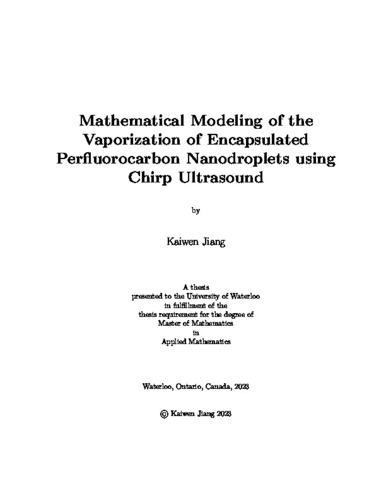| dc.contributor.author | Jiang, Kaiwen | |
| dc.date.accessioned | 2023-08-29 18:47:32 (GMT) | |
| dc.date.available | 2023-08-29 18:47:32 (GMT) | |
| dc.date.issued | 2023-08-29 | |
| dc.date.submitted | 2023-08-28 | |
| dc.identifier.uri | http://hdl.handle.net/10012/19795 | |
| dc.description.abstract | Ultrasound imaging is the use of sound waves beyond the human frequency range to construct images of human tissue. This is carried out through the measurement of reflected and scattered waves from the interfaces between tissues of differing acoustic impedances. Conventional ultrasound imaging faces limitations when imaging tissue microvasculature, resulting in poor resolution between blood and the surrounding tissue. This can be remedied using microbubbles which oscillate under ultrasound stimulation and thus provide an enhanced backscattered signal. Free gas bubbles however have a short half-life in the bloodstream as they are removed by the lungs. Therefore, phase-change contrast agents (PCCAs) have been introduced as an alternative which has better longevity in the body. An example of a PCCA is encapsulated perfluorocarbon nanodroplets. These nanodroplets are in liquid form when introduced into the body, but under exposure to ultrasound waves in the target tissue, undergo vaporization to form micrometer-scale bubbles. Therefore achieving a similar level of contrast enhancement to microbubbles. The encapsulation also confers them increased stability in circulation.
Typical use of ultrasound in medical imaging involves pulses of several wave cycles at constant frequency. Higher frequency ultrasound results in better axial resolution but a reduced penetrative depth as it undergoes a larger degree of attenuation within tissues. Coded excitation schemes where the outgoing ultrasound waveform is either frequency-modulated or phase-modulated can be utilized to increase axial resolution without sacrificing transmitted power and penetrative depth. One example of a coded excitation scheme is a linear chirp where the frequency of the ultrasound pulse increases linearly from the beginning to the end of the pulse.
The acoustic droplet vaporization of encapsulated perfluorocarbon nanodroplets under chirp ultrasound was investigated and it was found that although the increase in frequency over the course of the ultrasound pulse inhibits direct vaporization, if the stiffness of the encapsulating shell can be kept relatively low, there are feasible ultrasound parameters (amplitude, starting frequency and chirp bandwidth) which can still cause direct vaporization. This represents an improvement since the nanodroplets still fulfill their role as phase-change contrast agents and the chirp ultrasound fulfills its role of enhancing the axial resolution of the image. | en |
| dc.language.iso | en | en |
| dc.publisher | University of Waterloo | en |
| dc.subject | acoustic droplet vaporization | en |
| dc.subject | hyperelasticity | en |
| dc.subject | chirp ultrasound | en |
| dc.title | Mathematical Modeling of the Vaporization of Encapsulated Perfluorocarbon Nanodroplets using Chirp Ultrasound | en |
| dc.type | Master Thesis | en |
| dc.pending | false | |
| uws-etd.degree.department | Applied Mathematics | en |
| uws-etd.degree.discipline | Applied Mathematics | en |
| uws-etd.degree.grantor | University of Waterloo | en |
| uws-etd.degree | Master of Mathematics | en |
| uws-etd.embargo.terms | 0 | en |
| uws.contributor.advisor | Sivaloganathan, Sivabal | |
| uws.contributor.affiliation1 | Faculty of Mathematics | en |
| uws.published.city | Waterloo | en |
| uws.published.country | Canada | en |
| uws.published.province | Ontario | en |
| uws.typeOfResource | Text | en |
| uws.peerReviewStatus | Unreviewed | en |
| uws.scholarLevel | Graduate | en |

